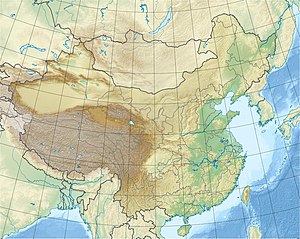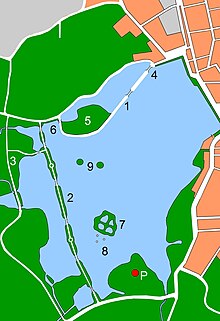West Lake
| West Lake | ||
|---|---|---|

|
||
| The West Lake near Hangzhou | ||
| Geographical location | China | |
| Location close to the shore | Hangzhou | |
| Data | ||
| Coordinates | 30 ° 14 '50 " N , 120 ° 8' 39" E | |
|
|
||
| length | 3.2 km | |
| width | 2.8 km | |
| Middle deep | 2.3 m | |
The West Lake ( Chinese 西湖 , Pinyin Xī Hú ) near the city of Hangzhou in Zhejiang is one of the largest tourist attractions in the People's Republic of China . A local name is Xīzǐ Hú ( 西子湖 ) based on Xīzǐ ( 西子 ), one of the four beauties of antiquity. The cultural landscape around the West Lake has been listed as a UNESCO World Heritage Site since 2011 .
The 3.2 km long and 2.8 km wide lake is divided by two dams. Both are named after famous poets who worked as officials in Hangzhou:
When the Chinese saying “There is paradise up there - down here there is Su- and Hangzhou ” ( 上 有 天堂 , 下 有 蘇杭。 / 上 有 天堂 , 下 有 苏杭。 , Shàng yǒu tiāntáng - xià yǒu Sū- Háng ), the beautiful landscape around the West Lake is automatically meant.
The West Lake was copied in many Chinese cities. There are a total of 36 western lakes in China and some in Japan. The lake stimulates the imagination of the Chinese and is the destination of many honeymoon trips.
Emergence
Legend has it that a pearl, around which a phoenix and a dragon quarreled, fell to the earth and formed the West Lake. In fact, the lake was created as a bay of the Qiantang River, which is three kilometers away today, in the 8th century. Back then, during the Tang Dynasty , the lake was dug by hand to its present depth of an average of 1.5 meters and separated from the river with a sandbank. The West Lake is about 650 hectares.
Attractions
The West Lake is divided into three parts by the short Bai Dam (in Plan 1) and the long Su Dam (named after the Song poet Su Dongpo ; 2). While the Su Dam was actually first constructed by Su Dongpo during his time as a civil servant in Hangzhou, the connection between Bai Dam and Bai Juyi is of a later date. Originally, Baidi simply meant "White Dam". A third old dam, the "Yanggong Dam" ( 杨公堤 , "Dam of the High Official Yang"; 3), now runs as a road on the west bank of the lake.
The bridge from the mainland to the Bai dam is called "Duanqiao" ( 断橋 , "pierced bridge"; 4). Originally, a lock was built there in 799 to control the water level of the lake. The lock was later replaced by today's bridge. It is one of the "Ten Sights of the West Lake". The largest and most important island in the West Lake can be reached via the Bai dam. It's called "Gushan" ( 孤山 , "Lonely Hill"; 5), so named after the mountain in the background. On the southern edge, where there are several buildings today, there was originally a palace that was built for the visit of the wife of Emperor Qianlong . You leave the island via the "Xiling Bridge" ( 西 冷 橋 , "Western Bridge of the Lonely Cold"; 6), which is also one of the ten sights.
In the middle of the lake is by far the largest of the three artificial islands, "Xiao Yingzhou" ( 小 瀛洲 , Small Paradise Island ; 7) with four small ponds, teahouses and gardens. South of the island, three small stone pagodas protrude from the water ( 三潭印月 , Santan Yinyue , the three depths that reflect the moon; 8). Two tiny islands lie between Gushan and Paradise Island: the eastern one is called “Huxinting” (in the palace that was built for the visit of the wife of Emperor Qianlong . You leave the island via the “Xiling Bridge” ( 湖心亭 , “ Pavilion in the heart of the lake ”; 9) and the western“ Ruangongdun ”( 阮公 墩 , islet of the high official Ruan; 9).
Another attraction is the Leifeng Pagoda ( 雷峰塔 , "Pagoda am Donnergifel"; P) in the south of the West Lake. It was built in 975, collapsed in 1924, but was rebuilt in 2002. Since then it has been a popular tourist attraction again.
The Ten Scenes of the West Lake
In the southern Song dynasty, ten picturesque locations and scenes by the lake were summarized for the first time under the term “Ten Scenes of the West Lake” ( 西湖 十景 ). Each scenery is described with a four-character term. Since the Qing dynasty, the ten places have been marked by steles that show the name of the respective scenery in the calligraphy of the Kangxi emperor. The ten scenarios are:
- Spring twilight on the Su Dam ( 蘇堤 春曉 / 苏堤 春晓 )
- Warbler singing in the pastures ( 柳浪聞鶯 / 柳浪闻莺 )
- Viewing the fish at the flower pond ( 花港觀魚 / 花港观鱼 )
- Lotus in the breeze on crooked courtyard ( 曲院風荷 / 曲院风荷 )
- Evening bells on Nanping Hill ( 南屏 晚鐘 / 南屏 晚钟 )
- Autumn moon over the calm lake ( 平湖秋月 )
- Leifeng Pagoda in the evening glow ( 雷 峰 夕照 )
- Three depths reflect the moon ( 三潭印月 , also motif of the Chinese 1 yuan note)
- Melting snow on the broken bridge ( 斷橋 殘雪 / 断桥 残雪 )
- Double peaks that pierce the clouds ( 雙峰 插 雲 / 双峰 插 云 )
Sights in and on the Westsee
- Su dam
- Bai dam
- "Pierced Bridge" / Duan Bridge
- Lingyin Temple
- Gushan Island
- Little Paradise Island (Xiao Yingzhou)
- Ruangongdun Island
- Temple of General Yue Fei
- Yuedai Bridge
- Lotus park
- Qiu Jin's tomb
Local transport
The closest station on Hangzhou Metro Line 1 is Longxiangqiao ( 龙翔 桥 , "Bridge to the Gliding Kite ") in Shangcheng District .
Picture gallery
literature
- Simon Hollege: A guide to Hangzhou and the West Lake. Rand McNally & Co, Chicago New York San Francisco. 1981.
Web links
Individual evidence
- ↑ UNESCO World Heritage Center: West Lake Cultural Landscape of Hangzhou. Retrieved August 19, 2017 .









